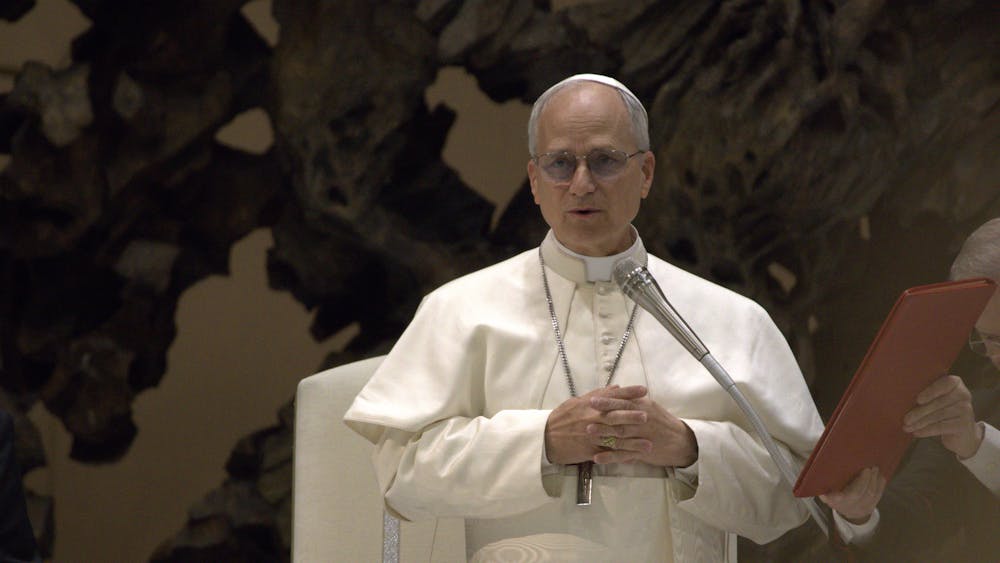Wednesday night in a crowded Eck Visitors Center auditorium, author and South Bend native Tess Gunty discussed her debut novel, "The Rabbit Hutch," which recently won the National Book Award for Fiction.
The novel has also won the Waterstones debut fiction prize and the Barnes & Noble Discover Prize.
Published on July 21, "The Rabbit Hutch" follows three summer days in the lives of the residents of the La Lapinière apartments, an affordable housing complex in fictional Vacca Vale, Indiana.
Throughout the early and mid-20th century, Vacca Vale was home to the thriving Zorn Automobiles company. However, in the decades since Zorn's collapse, Vacca Vale has become another dying Rust Belt city.
Gunty, a 2015 graduate of Notre Dame and graduate of Mishawaka's Marian High School, said South Bend greatly inspired Vacca Vale. Everything from Vacca Vale's physical map to the fact that its economy was once dominated by a now-defunct car company — a reference to South Bend's Studebaker history — reflects Gunty's hometown.
"When I was younger, I never had read anything that was set in a place like my town, and I think when you never see your home reflected back to you, you assume that stories just don't happen in the post-industrial Midwest, or there's no market for that," Gunty said.
She said when she was in college, she realized "these lives, these kinds of more-neglected places in America are worthy of attention" despite their lack of representation in literature.
Gunty added she chose to set "The Rabbit Hutch" in a fictional city so she could incorporate elements of other Rust Belt cities such as Gary, Indiana, Flint, Michigan, and Youngstown, Ohio, into the story.
Unlike South Bend, "there's no university in this book, so part of Vacca Vale is a thought experiment to imagine if South Bend had not had another source of identity, employment and economic energy to fall back on when Studebaker closed, what would have happened," Gunty said.
The road to getting published
Wednesday night, director of Notre Dame's creative writing program Roy Scranton and dean of the College of Arts and Letters Sarah Mustillo introduced Gunty, who was an English major with a concentration in creative writing while at Notre Dame.
Mustillo described Gunty's return to Notre Dame as a "celebration" and a testament to the strength of the creative writing program.
"Over the past few decades, the program has become one that we are all very proud of, a program that encourages and develops writing about a variety of themes, among them social justice, spirituality, violence, art, suffering, psychology, philosophy and the environment," Mustillo said.
Scranton explained that, while a student at Notre Dame, Gunty tutored in the Writing Center, wrote for Notre Dame Magazine, documented the history of the Center for Social Concerns and won a poetry award through the English Department.
Gunty said getting to speak at Notre Dame was the "most meaningful event" she has participated in related to "The Rabbit Hutch." Notre Dame was where she most developed as a writer, she said.
After graduating from Notre Dame, Gunty earned a master's degree in creative writing from New York University. It was while at NYU that she began developing and writing "The Rabbit Hutch," a process, she said, that took over five years.
While working on the novel, Gunty worked as a research assistant and a nanny and didn't always have a lot of time to write. She said she also started writing many novels and stories that she never finished or published.
She said these unfinished works represented an important step in the creation of "The Rabbit Hutch" and formed the "subterranean dirt" upon which the novel was built.
"I really credit my experiences at Notre Dame with really emphasizing process over anything else and emphasizing the importance of writing as an end in and of itself," Gunty said. "I never assumed that I would be published."
'Entrapment and freedom'
The main character of "The Rabbit Hutch," is 18-year-old Blandine Watkins, a recently aged-out former foster kid and a voracious reader with a special interest in the works of medieval Catholic mystics. Blandine lives in La Lapinière apartment C4 with three other former foster kids, Malik, Jack and Todd.
In addition to Blandine and her roommates, other La Lapinière residents, who the novel also follows, include Joan, the middle-aged editor of an obituary website; Hope, a young mother struggling to adjust to life with a newborn; and an older couple, former Zorn engineer Reggie and his wife Ida.
"I think that these characters are allowed to explore lots of different forms of entrapment and freedom," Gunty said.
She said Blandine is most aware of her entrapment and most trying to free herself from it.
"Various systems ... have been harmful to her, capitalism and the fossil fuel industry — which is kind of degrading her town, and also the patriarchy, which has made having a female body extremely dangerous for her," Gunty said.
Because of this, Blandine has a "kind of visceral, animal" reaction to being "trapped in a cage," Gunty continued.
"For every character, that's playing out in one way or another," she said.
Contact Claire Reid at creid6@nd.edu.









